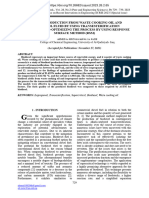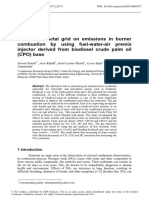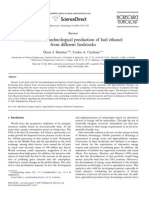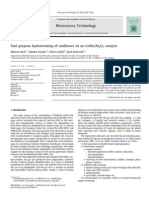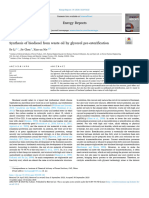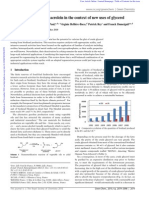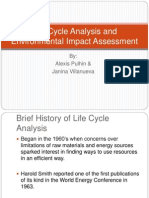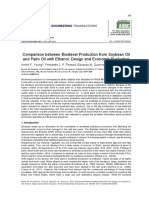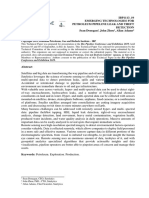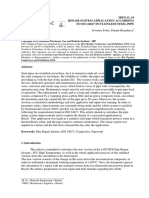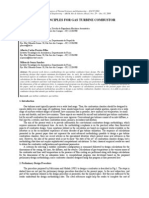System For Analysis of The Biodiesel Quality: Brazilian Petroleum, Gas and Biofuels Institute
System For Analysis of The Biodiesel Quality: Brazilian Petroleum, Gas and Biofuels Institute
Uploaded by
Marcelo Varejão CasarinOriginal Description:
Original Title
Copyright
Available Formats
Share this document
Did you find this document useful?
Is this content inappropriate?
Report this DocumentCopyright:
Available Formats
System For Analysis of The Biodiesel Quality: Brazilian Petroleum, Gas and Biofuels Institute
System For Analysis of The Biodiesel Quality: Brazilian Petroleum, Gas and Biofuels Institute
Uploaded by
Marcelo Varejão CasarinCopyright:
Available Formats
IBP1553_12 SYSTEM FOR ANALYSIS OF THE BIODIESEL QUALITY Dalton C. G. Valadares, Bruno A. F. Vitorino, Maria L.
Nascimento Neta 3, Ezequiel S. Batista4, Marcus V. D. Santos5, Franz H. Neff6, Elmar U. K. Melcher7, Edna N. Barros7
Copyright 2012, Brazilian Petroleum, Gas and Biofuels Institute - IBP
This Technical Paper was prepared for presentation at the Rio Oil & Gas Expo and Conference 2012, held between September, 1720, 2012, in Rio de Janeiro. This Technical Paper was selected for presentation by the Technical Committee of the event according to the information contained in the final paper submitted by the author(s). The organizers are not supposed to translate or correct the submitted papers. The material as it is presented, does not necessarily represent Brazilian Petroleum, Gas and Biofuels Institute opinion, or that of its Members or Representatives. Authors consent to the publication of this Technical Paper in the Rio Oil & Gas Expo and Conference 2012 Proceedings.
Abstract
This paper presents a system for analyzing the quality of biodiesel, through a new method of measuring oxidative stability. Its main component is a technique that makes use of ozone to accelerate the oxidation of the fuel, reducing, thus, the induction period, that is the parameter required for determining oxidative stability. Thanks to the reduction of the induction period, the current prototype reached results more rapidly than the standard method used in the industry. The prototype consists of an ozone generator, a microfluidic measuring cell (resistive sensor), a peristaltic pump and an embedded system for calculation of the induction period, storaging and sending the results to a server. An algorithm for automatic calculation of the induction period was developed. This algorithm and the results obtained with the new proposed method are shown. Keywords: Biodiesel, Oxidation Stability, Ozone, Quality Measuring, Embedded Systems.
1. Introduction
Diesel oil currently has a vital importance in the array of fuels in Brazil. A survey, conducted in 2005 by the Ministry of Mines and Energy (MME), reveals that more than half of Brazilian vehicles use this fuel in their engines. Besides the importance of diesel for the transport matrix of the country, it should also consider the massive use of this fuel in industrial motors, electric generators, sea and rail transport. On the other hand, reducing pollution is a worldwide objective today. Every day, studies and reports are published indicating the evils of global warming, and the use of fossil fuels has been identified as the main cause. Improving the environmental conditions, especially in large metropolitan centers, also means avoiding costs for governments and citizens in the combat to the evils of pollution. Such expenses are estimated at 900 million dollars annually in Brazil alone. Biodiesel is a fuel substitute for diesel oil. It is produced from renewable sources such as vegetable oils, animal fats, recycled greases and also used vegetable oils. The production process takes place through oil extraction of these components, submitted to mixtures and chemical reactions that give rise to biodiesel (B100). This process is called transesterification that is the reaction of an alcohol (usually methanol) with the parent vegetable or fat oil, in the presence of a basic catalyst, such as sodium or potassium hydroxide (Knothe 2001; Knothe 2006). Compared with mineral diesel, biodiesel has a higher density. This makes the process of monitoring the quality of this fuel type necessarily more rigid, because heating and long-term storage of vegetable oil can cause further decomposition reactions, where the products of reactions can lead to the formation of polymeric compounds. This may cause clogging of the injection pumps and valves, or other damage to equipment using this fuel (Tenbohlen and Koch, 2010; Knothe 2001; Knothe 2006).
______________________________ Specialist and Master Student, Computer Science, UFCG (Federal University of Campina Grande) Embedded Systems Developer, CETENE/LINCS (Center of Strategic Technologies of Northeast/Laboratory for Integration of Circuits and Systems) 2 Master, Electrical Engineering Electronic Engineer, CETENE/LINCS 3 Master Student, Computer Science, UFCG Project Manager, CETENE/LINCS 4 Undergraduate Student, Electrical Engineer, UFCG - Technical Researcher, CETENE/LINCS 5 Doctoral student, UFPE - Manager, CETENE/LINCS 6 Doctor, Physics Researcher, CETENE/LINCS 7 PhD, Computer Science Coordinator, CETENE/LINCS
Rio Oil & Gas Expo and Conference 2012 According to ANP (National Petroleum Agency) in order to evaluate the quality of biodiesel four parameters must be considered, which are indicators of degradation. They are: Specific mass, stability to oxidation, acidity index and water content. The oxidative stability of biodiesel is one of the factors that has been the subject of research. It is directly related to the degree of unsaturation of alkyl esters present, as well as the position of double bonds in the carbon chain. The concentration of alkyl esters with a high degree of unsaturation vary with the raw material in the production of biodiesel. The greater the number of unsaturations, the greater susceptibility of the molecule to thermal and oxidative degradation to form insoluble products, which cause problems of formation of deposits and fouling of the fuel injection system of the engine. Natural antioxidants from vegetable oils provide a greater resistance to oxidation (eg tocopherols), however, they may be lost during the refining process or by thermal degradation. The high temperature and exposure to air are important factors that affect the stability of biodiesel, however, it is significantly affected when these two factors are present simultaneously. The standard procedure for the determination of oxidative stability is the process known as "Rancimat" ( 743 Rancimat of Metrohm TM) and is defined by the EN 14112 (EN14112, 2003) norm of the European Committee for Standards (CEN). The same method can be found in standard ISO 6886. In the Rancimat, the oxidation process of biodiesel is accelerated by the action of temperature and oxygen from the air. The products formed by the oxidation are carried by an airflow to a conductivity cell containing distilled water. The induction time is determined by measuring the conductivity. The evaluation is completely automatic. One of the biggest problems of the approach proposed by EN 14112 are the long induction periods. A sample of oil may have induction periods varying from hours to several days. Another problem is the high cost of the method, which requires multiple devices of high commercial value. Additionally, the weight of the "Rancimat" is 27 kg and its use requires that a computer is connected to the device, which has characterized as a disadvantage of this approach, because it makes transport and mobility of the product difficult. This paper presents the development of an embedded electronic system that monitors accurately and effectively monitor the quality of biodiesel and oxidative stability in particular. This system allows monitoring in any of stages of production, transport, storage and sale of fuel and supports the monitoring of parameters via the Internet. Some concepts about oxidative stability and how to measure it are presented in Section 2. In Section 3 is presented the new method for calculate the oxidative stability, using ozone as oxidation accelerator for obtain lower induction periods. The results and conclusions are presented, respectively, in Sections 4 and 5.
2. Oxidative Stability
Due to the diversity of raw materials through which biodiesel can be obtained and the diversity of fatty acids that make up the oils and fats used, as result of the transesterification reaction, besides of biodiesel (major product) and glycerin (a byproduct) are also obtained some contaminants. Allied to these, other substances, such as residues of water and carbon, influence the quality of biodiesel (Knothe et al., 2005; Bannister et al., 2011). The quality of biodiesel is important for producers, engine manufacturers and consumers. Thus, tests to evaluate the several factors that influence the quality of biodiesel are required. Among them we can mention: total content of glycerol and mono-, di- and triglycerides, esters and linolenic acid content, acidity, cold filter plugging point (CFPP), pour point (PP), cloud point (CP), moisture content, index of water and sediment, carbon residues, flash point, kinematic viscosity, density and oxidative stability (ANP, 2008). In Brazil, the ANP, in resolution 07/2008, regulates the quality tests for biodiesel produced or sold in Brazil. Methods are standardized by the ASME, ASTM or EN/ISO (ANP, 2008). This paper focuses on a new method for determining the oxidative stability, that is defined as the susceptibility to oxidation of the fuel and is one of the most important factors to be considered when using biodiesel ( Bannister et al., 2011). The oxidation of biodiesel involves the change of various quality factors and certain physical and chemical properties. For example, the flash point slightly decreases and cetane number increases; a large variation in kinematic viscosity is observed, exceeding the limits imposed by standards for this factor (Bannister et al., 2011). Natural antioxidants can inhibit the degenerative process of oxidation of biofuels. However, for different storage media and biodiesel types are required different concentrations of antioxidant (Bannister et al., 2011). In a related work (Cavalcanti et al., 2007), experiments were performed using soy-based biodiesel, adding three types of antioxidants additives to different concentrations. There was an increase of more than 6 hours in the rate of oxidative stability, in one of the cases. The oxidative stability is therefore of paramount importance in determining the quality of biofuels. It is defined as the time required to reach the point of abrupt increase of the degree of oxidation. The measure is given in hours and is also known as induction period (Knothe et al., 2005; Bannister et al., 2011; ANP, 2008; Cavalcanti et al., 2007; EN14112, 2003; Barreto, 2005; Cetc and Tremblay, 2006; Garcia et al., 2006 ). For example, ANP establishes an induction period of at least 6 hours to biodiesel be considered fit for use. Among the techniques for measurement of oxidative stability, the most commonly used, from the induction period, is the Rancimat test, which is based on the standard EN14112. The Rancimat test is based on the oxidation acceleration of the fuel sample by heating and mixing with air. As shown in the block diagram of Figure 1, a flow of 2
Rio Oil & Gas Expo and Conference 2012 filtered air is inserted in the biodiesel sample, submitted to a temperature of 110 C through the heating block. With the degradation of the biodiesel, the acids and volatiles formed are carried by the air stream to a container with distilled water and deionized water and a sensor for conductivity measuring (in S/cm 3) of the solution.
Figure 1. Functional block diagram used in Rancimat test. The OSI (Oil Stability Index) is also used to measure oxidative stability of biodiesel, using an own equipment, defined in the standard ATSM D6751, or using the same apparatus as Rancimat, by calculating the index from the result obtained automatically (Bannister et al., 2011). Research has been conducted in order to obtain the induction period faster. Most studies use the Differential Scanning Calorimetry (DSC) as an alternative technique (Bannister et al., 2011; Garcia et al., 2006; Moser, 2009; Tan et al., 2002; Velasco et al., 2004). In one study (Tan et al., 2002), the induction periods obtained by DSC were 7-260% smaller than those obtained by means of OSI, technique similar to the Rancimat test. Another analysis technique that can be considered equivalent to the Rancimat method is Thermogravimetry (TG), a technique which determines the variation of mass of the sample from the effect of temperature over time (Garcia et al., 2006). It is noteworthy that the induction period does not represent all the phenomena of biodiesel oxidation, because only the volatiles products influence the measure. Based on this, other techniques are used to characterize the degradation and the consequent formation of oxidation products through analytical methods. Some of the methods used are: Nuclear Magnetic Resonance Spectroscopy (NMR Spectroscopy), Mass Spectrometry (MS), Fourier Transform Infrared Spectroscopy (FTIR Spectroscopy) and Gas-Chromatography - Mass Spectrometry (GC-MS). These techniques detect the presence of structures and chemical compounds which are formed during the oxidation process (Bannister et al., 2011). One common aspect to all techniques discussed previously is the need for use of laboratory equipment, requiring highly skilled personnel for operation. Thus, these solutions are not suitable for the implementation of portable monitoring systems for registration of oxidative stability in real time. The proposed method aims to meet this need, using a portable equipment and with real-time features, determining the oxidative stability faster and as reliable as the other methods.
3. Method of accelerated oxidation by ozone Ozomat
As the use of the techniques discussed above requires the use of laboratory equipment operated by highly qualified personnel, these are not appropriate solutions for the implementation of portable monitoring systems that allow the registration of the oxidative stability in real time. To implement the method Ozomat, O 3 was used as the sole accelerator of oxidation, being not necessary to use high temperatures, nor control them. The purpose of using O 3 is to obtain a shorter induction period, reducing the testing time. The ability of rapid testing, combined with relative simplicity of the method, makes possible to design a portable device, which is lacking in the industry (Cunha et al., 2011a,b). The solution proposed in this paper is based in accelerated oxidation of biodiesel, as well as in the methods Rancimat, OSI, DSC and TG. The test procedure proposed in this work demands the following steps: E1 - Generation of Ozone by discharges of dielectric barrier breaking; E2 - Mixture of ozone to the biodiesel sample; E3 - Measurement of electrical resistance of the biodiesel-ozone mixture; E4 - Automatic determination of oxidative stability by calculating the induction period. The steps necessarily follow that order, but continually occur throughout the measurement process. 3
Rio Oil & Gas Expo and Conference 2012 The functional block diagram of Ozomat is shown in Figure 2. Starting in an entry of dry air or oxygen, the ozone synthesizer using controlled electrical discharges generates a gas mixture composed mainly by O 3 and O2. The resulting gas is mixed with a biodiesel sample by bubbling. A peristaltic pump transports the solution to a measuring cell. Inside the measuring cell, a metal film is exposed to a solution of Biodisel + O 3 + O2, forming a resistive sensor. The electrical resistance of the sensor is measured and its temporal variation is used in the calculation of the induction period. A processing system performs the determination of oxidative stability, based on calculating the second derivative of the temporal curve of biodiesel conductivity subjected to oxidation. In subsequent subsections the design and implementation of the functional blocks will be described.
Figure 2. Functional block diagram used in Ozomat method. 3.1. Ozone Generator Ozone (O3), unstable allotropic form of oxygen in the air, is a gas found naturally in the upper portions of the atmosphere (stratosphere) and is formed from the interaction between O2 molecules and ultraviolet (UV) radiation from the sun. This gas can also be found in the lower layers of the atmosphere, but in low concentrations, from 20 to 35 parts per billion (ppb). The transformation of O 2 in O3 is given by the chemical reactions of cracking the oxygen molecule through a photon (hv), (I) and associating an oxygen atom with a molecule of O2 (II) (Lepine et al., 2008). The overall reaction is given by equation (III).
The high oxidation potential of O 3 is used in this method as accelerator of the degradation process of biodiesel. The O3 is artificially obtained using: ionization by electron beam, ionization by UV radiation, microwave discharges or by discharges of dielectric barrier breaking (Korenev and Korenev, 2004). The solution used in Ozomat is based on the dielectric barrier discharge (DBD). The blocks that make up the projected ozone generator can be seen in Figure 3. For generating plasma within the chamber of ozone, high voltage pulses are required. These pulses are generated by a voltage converter circuit, which has as input a square wave signal, generated by an oscillator.
Figure 3. Functional block diagram of the Ozone Generator. 4
Rio Oil & Gas Expo and Conference 2012 The oscillator circuit is based on the LM 555 timer, with adjustable output frequency between 400 Hz and 1000 Hz. For the implementation of the voltage converter, shown in Figure 4, was used an autotransformer T1 whose input is switched through the pulses generated by the oscillator . As a switching element it was used a power MOSFET. The operating voltage of the generator is 20 kV.
Figure 4. Electric circuit of the pulse generator. The cross section of the chamber of ozone is shown in Figure 5. The anode was implemented through a deposition of a silver layer on a dielectric (glass). The cathode is a piece of aluminum, at the bottom of the chamber. A space between the dielectric glass layer and the cathode is the site of formation of the plasma. The structure fixation is made with nylon parts. The ozone generation region has volume of 6,22 cm 3. The ozone concentration was 260 ppm, when applying a voltage of 20 kV at the terminals of the chamber as input and using dry air .
Figure 5. Ozone chamber. Aiming to submit biodiesel to the rapid oxidation process, the O 3 ozone generated in the chamber is continuously bubbled in the biodiesel sample. A fuel flow passes through the interior of a microfluidic cell, comprising a resistive sensor. To obtain the flow, a peristaltic pump was used, to allow the transport of fluids and gases through the peristaltic movements. The pump designed to Ozomat is based on the speed control of a stepper motor. As can be seen in Figure 6, a piece of aluminum, which includes three pumping elements is coupled to the stepper motor. Each pumping element is a bearing, that presses a tube when rotated, creating a flow of fuel in the direction of the motor rotation. The motor speed is controlled by a PIC microcontroller. The pump has a flow rate of up to 10 ml/min.
Rio Oil & Gas Expo and Conference 2012
Figure 6. Peristaltic pump. 3.2. Measurement of resistive sensor As in other methods of measuring oxidative stability, the end of the first step of biodiesel oxidation, called induction period, must be detected. To obtain the induction period, the oxidation of biodiesel is characterized by the temporal variation of the fuel resistance, measured by a resistive sensor. A microfluidic cell (Figure 7) includes the sensor, manufactured with the deposition of a metal layer of 50nm. Biodiesel comes into contact with the metal within the cell. The design of the metal deposition has the shape of two symmetric fingers separated by a gap of 1 mm, place of the resistance measurement. The terminals of the resistor are glued in the metal deposition of the outside of the measuring cell, as shown in Figure 8. The resistance is measured by an ohmmeter and has values between 1.5 and 3.5 M (Mohms). Through an acquisition circuit with Analog to Digital Converter, the temporal variation of resistance is used to characterize the biodiesel oxidation and to automatic calculate the induction period, in the processing system.
Figure 7. Measuring cell - Cross section.
Figure 8. Sensor, metal deposition. 3.3. Determination of Induction Period The automatic determination of the induction period, from the time variation of the conductivity of biodiesel, is defined, in the standard EN14112 (EN14112, 2003), as the maximum point of the second derivative of the conductivity 6
Rio Oil & Gas Expo and Conference 2012 curve. Since there is no analytical expression of conductivity, the second derivative should be obtained numerically. The calculation of the second derivative is much hampered by the presence of signal noise. A signal with frequency noise f has the second derivative with amplitude proportional to f2, being, this way, very difficult to calculate the induction period without the use of filtering techniques. Techniques called smoothing derivatives were studied, used to reduce the effect of noise in the calculation of derivatives. Four types of smoothing were tested: rectangular, triangular, pseudo-Gaussian and Savitzky-Golay (OHaver, 2012; Savitzky and Golay, 1964; Schafer, 2011; Kitamura and Hozumi, 1987). The filter that showed better results for the calculation of the induction period was the triangular filter, which formula, using 5-points is given by:
The algorithm for automatic determination of the induction period performs the following tasks: calculation of conductivity based on the resistance value measured at the sensor; calculation of the smoothing filter; calculation of the second derivative and determination of the maximum of the second derivative. The flowchart of Figure 9 represents the algorithm capable of automatically determining the induction period, used by the processing system.
Figure 9. Algorithm of automatic induction period detection. 3.4. Embedded System for Processing and Storage The monitoring system presented in this paper needs to calculate the induction period, for determining oxidative stability, and storing these results, for later analysis. This is performed by an embedded system in which an algorithm is implemented for determination of oxidative stability, through the induction period. Such a system will have a screen for communication with users and data visualization. These data will be stored on a server and thus will be available also through a web system. The proposed solution, allows to record, besides of the oxidative stability, three other quality metrics: acidity (pH), density and moisture. These measurements are carried out periodically, through specific sensors. To automate this process, minimizing systematic errors arising from the possible presence of human operators, it was designed a software architecture in which the collected data is sent to an embedded system, via a serial communications port, and this, through an appropriate protocol, communicates with a server database. The availability of the results is performed by an application, which can be accessed by any device with a web browser, since it is connected to the network and has access credentials. The embedded system that calculate the induction period also follows this software architecture.
4. Results
Experimental results were obtained using the Ozomat system. In the experiments, it was used a prototype which implements the block diagram of Fig. 2, without the processing system. Two samples of cotton seed oil biodiesel 7
Rio Oil & Gas Expo and Conference 2012 (Cotton Seed Oil - Fatty Acid Methyl Esters CSO-FAME) were analyzed, one without the addition of antioxidants and other with addition of butylated hydroxytoluene (BHT). In Figure 10 is shown the temporal variation of the conductivity of CSO-FAME sample with BHT. Throughout the analysis time (38 min), the conductivity of the sample was practically unchanged, as expected for a sample with antioxidant. The experiment result of oxidation of biodiesel without BHT is shown in Figure 11. The induction period, determined by visual inspection of the chart was of 1740s, time interval between the admission of O 3, in 420s, and the sudden increase in conductivity, observed in 2160s. This result qualitatively proves the efficacy of Ozomat, as the two phases of oxidation can be observed and the induction period can be calculated. The development of the algorithm for automatic detection of induction period was performed after the study of smoothing filters. The simplest filter whose result allowed the automatic calculation of the induction period was a triangular filter with equation of 21 points. The result of applying the filter is shown in Figure 12. The induction period may be detected from the maximum point of the second derivative of the filtered signal. The noise in the original conductivity signal caused no error in the measurement of the it. The induction period calculated was 1778s, similar to obtained time with visual inspection.
Figure 10. Electrical conductivity of sample CSO-FAME with addition of antioxidant BHT, ozone allowed in 200s.
Figure 11. Electrical conductivity of the CSO-FAME sample without antioxidant, ozone allowed in 420s.
Rio Oil & Gas Expo and Conference 2012
Figure 12. Second derivative and conductivity of the CSO-FAME sample without antioxidant applied triangular filter.
5. Conclusions
As seen, a new method for determining oxidative stability, in biofuels, was developed. This method is based on the acceleration of the oxidation of biofuel through ozone. Thanks to the use of ozone, as an accelerator of the oxidation, the results obtained with the proposed method presented lower induction periods than the results obtained with Rancimat. This way, with the new method has been achieved a faster analysis. It was found that the ozone concentrations necessary for the rapid oxidation of biodiesel are not considered harmful, being only needed to take extra care with the isolation of the gas so that the components of the equipment are not degraded. Furthermore, the elaborated prototype allows the measurement of the oxidative stability in fields/plants, laboratories or even during shipment and storage of biofuel, because of its portability and ease of movement, which turns out to be another advantage over other methods most widely used in industry. With the automatic calculation of the induction period and the rate control of ozone production, it is possible to perform measurements in real time.
7. Acknowledgements
Thanks to CNPq and CETENE / LINCS by the financial support of the project, and to all who contributed to the system design and project progress.
8. References
ANP (National Petroleum Agency), ANP Resolution, Number 7/2008. 2008 BANNISTER, C. D., CHUCK, C. J., BOUNDS, M., HAWLEY, J. G. Oxidative stability of biodiesel fuel, Proceedings of the Institution of Mechanical Engineers Part D Journal of Automobile Engineering, vol. 80, no. 10, pp. 10471048, 2011. BARRETO, A., Avaliao da Tendncia Biocorroso e da Estabilidade Oxidao de Biodiesel Metlico de Soja e Mistura B5 Anlises FsicoQumicas, Congresso de Biodiesel, pp. 201-206, 2005. CAVALCANTI, E., TOMACHUK, C. R., ARAJO, F. D. V. L., FERRAZ, O., MARQUES, L. G. C., Controle da Estabilidade Oxidativa de Biodiesel de Soja atravs de Mistura de Aditivos antioxidantes, in II Congresso da Rede Brasileira de Tecnologia Biodiesel, 2007. CETC, N. C. O., TREMBLAY, A., Study of the Rancimat Test Method in Measuring the Oxidation Stability of Biodiesel Ester and Blends, November, 2006. CUNHA, H. do N., MELCHER, E. U. K., VASCONCELOS NETO, W. R., SILVA, F. L. A. J., NEFF, F. H. Determinao da estabilidade oxidativa de leos e combustveis utilizando oxidao acelerada com Oznio (Patente PI1002057 - Nmero de depsito), U.S. Patent PI1002057 - Nmero de depsito, 2011a. CUNHA, H. do N., SILVA, F. L. A. J., MELO, J., CAVALCANTI, E. H. S., FONSECA, T. M., MELCHER, E. U. K., 9
Rio Oil & Gas Expo and Conference 2012 LIMA, A. M. N., LABORDE, H. M., NEFF, F. H. The interaction of ozone with bio-fuel, revealed by electrical conduction and infrared spectroscopy. Fuel Processing Technology 92 (11) p. 2160-2168, 2011b. EN14112, 2003. Fat and Oil Derivatives Fatty Acid Methyl Esters (FAME) Determination of oxidation stability (accelerated oxidation test). 2003. GARCIA, C. C., COSTA, J. B., VECHIATTO, W. W. B., ZAGONEL, F. G., SUCHEK, E. M., ANTONIOSI FILHO, N. R., LELES, M. I. G. Estudo comparativo da estabilidade oxidativa de diferentes biodiesel por termogravimetria (TG) e teste rancimat, in I Congresso da Rede Brasileira de Tecnologia do Biodiesel, pp. 263-267, 2006. KITAMURA, K., HOZUMI, K. Effect of Savitzky-Golay smoothing on second derivative spectra. Analytica Chimica Acta, 201, pp.301-304., 1987. KNOTHE, G., Analytical methods used in the production and fuel quality assessment of biodiesel. In: Transactions of the ASAE v. 44 (2), p. 193-200, 2001. KNOTHE, G., Analyzing biodiesel: standards and other methods. Journal of the American Oil Chemists Society, v. 83 (10), p. 823-833, 2006. KNOTHE, G., KRAHL J., VAN GERPEN, J. The Biodiesel Handbook, AOCS Press, 2005. KORENEV, S., KORENEV, I. Compact pulsed ozone generator. In Power Modulator Symposium 2004 and 2004 HighVoltage Workshop Conference Record of the TwentySixth International. pp. 352-355. LPINE, L., LESSARD-DZIEL, D., BLEC, Mario, GUDDEMI, C., NGUYEN, D. N. Using Ozone Measurements to Diagnose Partial Discharge in Generators. Hydro Review. Vol. 27, Issue: 7, 2008. MOSER, B. R., Comparative Oxidative Stability of Fatty Acid Alkyl Esters by Accelerated Methods, Journal of the American Oil Chemists Society, vol. 86, no. 7, pp. 699-706, 2009. OHAVER, T., 2012. An Introduction to Signal Processing in Chemical Analysis. Available at: http://terpconnect.umd.edu/~toh/spectrum/Differentiation.html [Accessed April 20, 2012] SAVITZKY, A., GOLAY, M. J. E. Smoothing and Differentiation of Data by Simplified Least Squares Procedures. Analytical Chemistry, 36(8), pp.1627-1639. 1964. SCHAFER, R. W. What is a Savitzky-Golay Filter? IEEE Signal Processing Magazine, (July), pp.111-117. 2011. TAN, C. P., CHE MAN, Y. B., SELAMAT, J., YUSOFF, M. S. A., Comparative studies of oxidative stability of edible oils by differential scanning calorimetry and oxidative stability index methods, Food Chemistry, vol. 76, no. 3, pp. 385-389, 2002. TENBOHLEN, S., KOCH, M. Aging Performance and Moisture Solubility of Vegetable Oils for Power Transformers. IEEE Transactions on Power Delivery, v. 25 (2), p. 825830, 2010. 743 Rancimat of Metrohm, Ionenanalytik, Metrohm AG, CH-9101 Herisau, Ch. VELASCO, J., ANDERSEN, M. L., SKIBSTED, L. H., Evaluation of oxidative stability of vegetable oils by monitoring the tendency to radical formation. A comparison of electron spin resonance spectroscopy with the Rancimat method and differential scanning calorimetry, Food Chemistry, vol. 85, no. 4, pp. 623-632, 2004.
You might also like
- Production of Biodiesel From Fish Waste and Characterization of Produced Biodiesel.Document9 pagesProduction of Biodiesel From Fish Waste and Characterization of Produced Biodiesel.Allan Zander Chris G. UrpinaNo ratings yet
- The Use of Nonconventional Fuels To Internal Combustion EnginesDocument10 pagesThe Use of Nonconventional Fuels To Internal Combustion EnginesshyleshaNo ratings yet
- Severson Et Al - Optimal Biodiesel Production Using Bioethanol Towards Process IntegrationDocument24 pagesSeverson Et Al - Optimal Biodiesel Production Using Bioethanol Towards Process IntegrationfksfjksjNo ratings yet
- J Fuel 2011 09 011Document6 pagesJ Fuel 2011 09 011Lorraine OliveiraNo ratings yet
- 3108-Article Text-9252-1-10-20231224Document11 pages3108-Article Text-9252-1-10-20231224Naufal FawwazNo ratings yet
- Aceite de FrituraDocument8 pagesAceite de FrituraNestor Andres Urbina SuarezNo ratings yet
- Gas TurbineDocument6 pagesGas TurbineAditya GuptaNo ratings yet
- A Review On The Current State of The Art For The Production of Advanced Liquid BiofuelsDocument31 pagesA Review On The Current State of The Art For The Production of Advanced Liquid BiofuelsMarcelo TavaresNo ratings yet
- Biodiesel Production From Used Cooking Oil in Local Communities - A Sustainable Solution For The PhilippinesDocument4 pagesBiodiesel Production From Used Cooking Oil in Local Communities - A Sustainable Solution For The Philippineskereysha daradalNo ratings yet
- Biodiesel From Waste Cooking OilDocument6 pagesBiodiesel From Waste Cooking OilJam imtiazNo ratings yet
- Matecconf Aigev2017 01073 PDFDocument7 pagesMatecconf Aigev2017 01073 PDFNadiedaNo ratings yet
- R19 Mohebali and Ball 2008Document15 pagesR19 Mohebali and Ball 2008Andres RojasNo ratings yet
- Imp 2Document8 pagesImp 2Shivam PandyaNo ratings yet
- Trends in Biotechnological Production of Fuel Ethanol From Different FeedstocksDocument26 pagesTrends in Biotechnological Production of Fuel Ethanol From Different FeedstocksPatricio LeonardoNo ratings yet
- Ferdinand B Ar, Markus Knorr, Olaf SCHR Oder, Henning Hopf, Thomas Garbe, Jürgen KrahlDocument12 pagesFerdinand B Ar, Markus Knorr, Olaf SCHR Oder, Henning Hopf, Thomas Garbe, Jürgen KrahlGuisela Carbajal RomeroNo ratings yet
- An Intensified Reactive Separation Process For Bio-1-10Document10 pagesAn Intensified Reactive Separation Process For Bio-1-10klpiNo ratings yet
- Liquid-Liquid Equilibrium For Ternary System Containing Biodiesel, Methanol and WaterDocument8 pagesLiquid-Liquid Equilibrium For Ternary System Containing Biodiesel, Methanol and WaterAdani Ghina Puspita SariNo ratings yet
- Analysis of The Physical and Chemical Characteristics of Vegetable Oils As FuelDocument10 pagesAnalysis of The Physical and Chemical Characteristics of Vegetable Oils As Fuelnaveed54No ratings yet
- Improved Cold-Flow AdditivesDocument13 pagesImproved Cold-Flow AdditivesJudianto HasanNo ratings yet
- 10 1016@j Fuel 2017 07 014Document8 pages10 1016@j Fuel 2017 07 014Hugo VillardiNo ratings yet
- 68 Waste Management in Oil and Gas IndustriesDocument3 pages68 Waste Management in Oil and Gas IndustriesEjike Francis ChizobaNo ratings yet
- Martinez Hernandez2019Document11 pagesMartinez Hernandez2019Thế vũ Đặng vănNo ratings yet
- Biodiesel: An Alternative To Conventional Fuel: Energy ProcediaDocument12 pagesBiodiesel: An Alternative To Conventional Fuel: Energy ProcediaAkash DeepNo ratings yet
- Research 4Document6 pagesResearch 4Mahtab SajnaniNo ratings yet
- Combustible Con Hidrógeno de Aceite de GirasolDocument7 pagesCombustible Con Hidrógeno de Aceite de Girasolluis carlos castilloNo ratings yet
- 2nd AUN-SEED.B - 004Document6 pages2nd AUN-SEED.B - 004Ullash JayedNo ratings yet
- Gliserol Dalam BiodiselDocument4 pagesGliserol Dalam BiodiselmuthiNo ratings yet
- Jacobson-Taking Your Digester Gas - FinalDocument25 pagesJacobson-Taking Your Digester Gas - Finalnonyabis1No ratings yet
- Questions & Answers: Innovations For Greenhouse Gas ReductionsDocument7 pagesQuestions & Answers: Innovations For Greenhouse Gas ReductionsPrince AliNo ratings yet
- Salvatore J. Rand: MNL1-EB/May 2010Document2 pagesSalvatore J. Rand: MNL1-EB/May 2010Alfonso MartínezNo ratings yet
- SyngasDocument160 pagesSyngasnvinson100% (1)
- Lca For Palm BiodieselDocument7 pagesLca For Palm BiodieselLai Mei EeNo ratings yet
- Operational Experience With Biofuels & Analysis of NOx, SOx Emissions (2023 by Delft)Document40 pagesOperational Experience With Biofuels & Analysis of NOx, SOx Emissions (2023 by Delft)LelosPinelos123No ratings yet
- Upgrading of Waste Oils Into Transportation Fuels Using Hydrotreating TechnologiesDocument3 pagesUpgrading of Waste Oils Into Transportation Fuels Using Hydrotreating TechnologiesMarcelo MisutsuNo ratings yet
- Enhancement of Production and Upgradation of Biogas Using Different Techniques-A ReviewDocument17 pagesEnhancement of Production and Upgradation of Biogas Using Different Techniques-A ReviewZainul Fikri TampengNo ratings yet
- Energies 11 02845Document13 pagesEnergies 11 02845hariprasadr5199No ratings yet
- Synthesis of biodiesel from waste oil by glycerol pre-esterificationDocument6 pagesSynthesis of biodiesel from waste oil by glycerol pre-esterificationFTGDIASNo ratings yet
- BLT 2705 BiostabDocument88 pagesBLT 2705 Biostabrn_svnitNo ratings yet
- Biodiesel ProductionDocument32 pagesBiodiesel ProductionSafdar ShaikhNo ratings yet
- Glycerol Dehydration To Acrolein in The Context of New Uses of GlycerolDocument20 pagesGlycerol Dehydration To Acrolein in The Context of New Uses of GlycerolBernyke ContracyNo ratings yet
- Technoeconomic StudyDocument5 pagesTechnoeconomic StudyElizabeth ThompsonNo ratings yet
- Background 1Document8 pagesBackground 1KuIzzuNo ratings yet
- BiogasDocument15 pagesBiogasfluturasroz24No ratings yet
- Simulation Bio Ethanol Production - FinalDocument10 pagesSimulation Bio Ethanol Production - FinalJoseph McMullen100% (1)
- Bezergianni 2011Document6 pagesBezergianni 2011mayaNo ratings yet
- Biodiesel Separation and Purification A ReviewDocument7 pagesBiodiesel Separation and Purification A ReviewKarla SotoNo ratings yet
- Isooctane: Catalytic DistillationDocument12 pagesIsooctane: Catalytic DistillationAashish GauravNo ratings yet
- Hilb Ers 2015Document8 pagesHilb Ers 2015Ha SolevraNo ratings yet
- Paper No.1 - (2021) The Utilization of Biodiesel From Palm Oil and Palm Kernel Oil by Using Reactor With Different Stirred Method in A Diesel Engine.Document15 pagesPaper No.1 - (2021) The Utilization of Biodiesel From Palm Oil and Palm Kernel Oil by Using Reactor With Different Stirred Method in A Diesel Engine.Aphisik PakdeekaewNo ratings yet
- Leonardo, Murta Valle e Dweck (2017)Document7 pagesLeonardo, Murta Valle e Dweck (2017)Laís C. PoletoNo ratings yet
- Life Cycle Analysis and Environmental Impact Assessment97Document63 pagesLife Cycle Analysis and Environmental Impact Assessment97Alexis PulhinNo ratings yet
- A of The Available Technologies For Biodiesel Production Based On A Comparison of Different Feedstock's PropertiesDocument7 pagesA of The Available Technologies For Biodiesel Production Based On A Comparison of Different Feedstock's PropertiesFernanda PerezNo ratings yet
- Conceptual Design of A Separation Process For Higher Alcohols Made Bycatalytic Condensation of Ethanol 2090 4568 1000134Document9 pagesConceptual Design of A Separation Process For Higher Alcohols Made Bycatalytic Condensation of Ethanol 2090 4568 1000134shridharNo ratings yet
- Biodiesel Current Technology UltrasonicDocument32 pagesBiodiesel Current Technology UltrasonicMaka MagnaretogneNo ratings yet
- Stability of Biodiesel: Heinrich PranklDocument10 pagesStability of Biodiesel: Heinrich PranklIAMANDU COSTANo ratings yet
- Design and Fabrication of Low Cost Compact Biodiesel Production Plant PDFDocument8 pagesDesign and Fabrication of Low Cost Compact Biodiesel Production Plant PDFsree0% (1)
- 055 PDFDocument6 pages055 PDFImane ARNo ratings yet
- Oxy-Combustion Technology Development For Fluid CaDocument11 pagesOxy-Combustion Technology Development For Fluid Cashahnaz skNo ratings yet
- Advances in Biofeedstocks and Biofuels, Volume 2: Production Technologies for BiofuelsFrom EverandAdvances in Biofeedstocks and Biofuels, Volume 2: Production Technologies for BiofuelsLalit Kumar SinghNo ratings yet
- IBP1146 - 19 Maintenance Productivity Measurement Study at TranspetroDocument8 pagesIBP1146 - 19 Maintenance Productivity Measurement Study at TranspetroMarcelo Varejão CasarinNo ratings yet
- Riopipeline2019 1138 Rio Paper Rev01 PDFDocument11 pagesRiopipeline2019 1138 Rio Paper Rev01 PDFMarcelo Varejão CasarinNo ratings yet
- Riopipeline2019 1137 201906031307ibp1137 19 Increas PDFDocument10 pagesRiopipeline2019 1137 201906031307ibp1137 19 Increas PDFMarcelo Varejão CasarinNo ratings yet
- IBP1142 - 19 Offshore Development: Submarine Pipelines-Soil InteractionDocument13 pagesIBP1142 - 19 Offshore Development: Submarine Pipelines-Soil InteractionMarcelo Varejão CasarinNo ratings yet
- IBP1141 - 19 The Use of Optical Sensor To Investigate Dissolved Oxygen in CrudeDocument12 pagesIBP1141 - 19 The Use of Optical Sensor To Investigate Dissolved Oxygen in CrudeMarcelo Varejão CasarinNo ratings yet
- IBP1128 - 19 In-Service Welding Hot Tap of Refinary Pipeline With Hydrogen and EthyleneDocument10 pagesIBP1128 - 19 In-Service Welding Hot Tap of Refinary Pipeline With Hydrogen and EthyleneMarcelo Varejão CasarinNo ratings yet
- Riopipeline2019 1140 Ibp 1140 Nao Intrusivos Final PDFDocument4 pagesRiopipeline2019 1140 Ibp 1140 Nao Intrusivos Final PDFMarcelo Varejão CasarinNo ratings yet
- Riopipeline2019 1127 Article Number Ibp1127 19 PDFDocument10 pagesRiopipeline2019 1127 Article Number Ibp1127 19 PDFMarcelo Varejão CasarinNo ratings yet
- Riopipeline2019 1124 Worlds First Remote Deepwater PDFDocument10 pagesRiopipeline2019 1124 Worlds First Remote Deepwater PDFMarcelo Varejão CasarinNo ratings yet
- Riopipeline2019 1126 Article Number Ibp1126 19 PDFDocument11 pagesRiopipeline2019 1126 Article Number Ibp1126 19 PDFMarcelo Varejão CasarinNo ratings yet
- Riopipeline2019 1135 Riopipeline2019 t1135 JST Av1Document8 pagesRiopipeline2019 1135 Riopipeline2019 t1135 JST Av1Marcelo Varejão CasarinNo ratings yet
- Riopipeline2019 1120 Ibp1120 19 Transpetro S Worklo PDFDocument9 pagesRiopipeline2019 1120 Ibp1120 19 Transpetro S Worklo PDFMarcelo Varejão CasarinNo ratings yet
- IBP1123 - 19 Caliper Ili Experience in Offshore Pre-CommissioningDocument10 pagesIBP1123 - 19 Caliper Ili Experience in Offshore Pre-CommissioningMarcelo Varejão CasarinNo ratings yet
- Riopipeline2019 1121 201906051235ibp1121 19 Final PDFDocument8 pagesRiopipeline2019 1121 201906051235ibp1121 19 Final PDFMarcelo Varejão CasarinNo ratings yet
- IBP1119 - 19 Internal Corrosion Detection: Conference and Exhibition 2019Document4 pagesIBP1119 - 19 Internal Corrosion Detection: Conference and Exhibition 2019Marcelo Varejão CasarinNo ratings yet
- IBP1122 - 19 High Grade Sawl Linepipe Manufacturing and Field Weld Simulation For Harsh EnvironmentsDocument11 pagesIBP1122 - 19 High Grade Sawl Linepipe Manufacturing and Field Weld Simulation For Harsh EnvironmentsMarcelo Varejão CasarinNo ratings yet
- Riopipeline2019 1113 201906031824ibp Riopipeline 11 PDFDocument10 pagesRiopipeline2019 1113 201906031824ibp Riopipeline 11 PDFMarcelo Varejão CasarinNo ratings yet
- IBP1110 - 19 The Relevance of Fuel Transmission Pipelines in BrazilDocument10 pagesIBP1110 - 19 The Relevance of Fuel Transmission Pipelines in BrazilMarcelo Varejão CasarinNo ratings yet
- Riopipeline2019 1117 Ibp1117 19 Versao Final para e PDFDocument8 pagesRiopipeline2019 1117 Ibp1117 19 Versao Final para e PDFMarcelo Varejão CasarinNo ratings yet
- Riopipeline2019 1107 201905201751ibp1107 19 Jacques PDFDocument7 pagesRiopipeline2019 1107 201905201751ibp1107 19 Jacques PDFMarcelo Varejão CasarinNo ratings yet
- Riopipeline2019 1112 FM 1112 FinalDocument10 pagesRiopipeline2019 1112 FM 1112 FinalMarcelo Varejão CasarinNo ratings yet
- Riopipeline2019 1090 201906111002ibp1090 19 The Rol PDFDocument9 pagesRiopipeline2019 1090 201906111002ibp1090 19 The Rol PDFMarcelo Varejão CasarinNo ratings yet
- IBP1111 - 19 Best Alternative For Rigid Offshore Pipelines Decommissioning - A Case StudyDocument13 pagesIBP1111 - 19 Best Alternative For Rigid Offshore Pipelines Decommissioning - A Case StudyMarcelo Varejão CasarinNo ratings yet
- Riopipeline2019 1104 201906031512fm 3811 00 Formato PDFDocument11 pagesRiopipeline2019 1104 201906031512fm 3811 00 Formato PDFMarcelo Varejão CasarinNo ratings yet
- IBP1101 - 19 Element Simulations and Offshore ObservationsDocument13 pagesIBP1101 - 19 Element Simulations and Offshore ObservationsMarcelo Varejão CasarinNo ratings yet
- IBP1099 - 19 Deep Water Pip Installation Using Reel-Lay MethodDocument12 pagesIBP1099 - 19 Deep Water Pip Installation Using Reel-Lay MethodMarcelo Varejão CasarinNo ratings yet
- IBP 1102 - 19 A Gas Routing Identification System On A Pipeline NetworkDocument12 pagesIBP 1102 - 19 A Gas Routing Identification System On A Pipeline NetworkMarcelo Varejão CasarinNo ratings yet
- IBP1095 - 19 in Flexible Pipes Systems and AncillariesDocument8 pagesIBP1095 - 19 in Flexible Pipes Systems and AncillariesMarcelo Varejão CasarinNo ratings yet
- Riopipeline2019 1093 201905221205final Paper Overpi PDFDocument12 pagesRiopipeline2019 1093 201905221205final Paper Overpi PDFMarcelo Varejão Casarin100% (1)
- Cargo Work: (IMO MODEL COURSE 7.03 REF. NO 2.2.1.)Document10 pagesCargo Work: (IMO MODEL COURSE 7.03 REF. NO 2.2.1.)MayankNo ratings yet
- Introduction To Solid State Physics: Luc Huy HoangDocument22 pagesIntroduction To Solid State Physics: Luc Huy HoangThanh DinhNo ratings yet
- Dynamic Simulation of Volume Fraction and Density PDFDocument6 pagesDynamic Simulation of Volume Fraction and Density PDFArpit DwivediNo ratings yet
- Physical Science PPT w1Document60 pagesPhysical Science PPT w1OhMy J4KE100% (2)
- SA FET Y#: Technical Data SheetDocument3 pagesSA FET Y#: Technical Data SheetDevi Gusni YantiNo ratings yet
- COURSE TITLE Industrial Chemistry IIDocument3 pagesCOURSE TITLE Industrial Chemistry IIashenafi100% (1)
- Concrete Terms and Industry TerminologyDocument12 pagesConcrete Terms and Industry TerminologyNguyen Dang Hanh100% (8)
- Gun Barrel Sizing For Crude Oil DehydrationDocument3 pagesGun Barrel Sizing For Crude Oil DehydrationRicardo BecNo ratings yet
- The Effect of Heat Treatment On The Structure of Scale LayerDocument8 pagesThe Effect of Heat Treatment On The Structure of Scale LayerNoel FrancisNo ratings yet
- Examples On CH 2Document4 pagesExamples On CH 2Abyssinia EthiopiaNo ratings yet
- Mitigation Strategy For Sulfur Deposits in Gas PipelinesDocument2 pagesMitigation Strategy For Sulfur Deposits in Gas PipelinesNorfolking100% (1)
- Experiment No. 6: Preparation and Standardization of Silver Nitrate Solution (Agno)Document3 pagesExperiment No. 6: Preparation and Standardization of Silver Nitrate Solution (Agno)Banana Q0% (1)
- Chemistry - Chemistry Form 1 - Question PaperDocument13 pagesChemistry - Chemistry Form 1 - Question PapermwendwavalerieNo ratings yet
- AWS D10.4-86R - Recommended Practices For Welding Austenitic Chromium - Nickel Stainless Steel Piping and TubingDocument40 pagesAWS D10.4-86R - Recommended Practices For Welding Austenitic Chromium - Nickel Stainless Steel Piping and TubingqaNo ratings yet
- Investigation of Leakage Paths in Well Abandonment OperationsDocument121 pagesInvestigation of Leakage Paths in Well Abandonment OperationsNourden AlNo ratings yet
- 3DT177Document11 pages3DT177dalton2004No ratings yet
- ABG ElectrolytesDocument48 pagesABG ElectrolytesDRwaqas Gulzar100% (1)
- Molecular Basis of InheritanceDocument3 pagesMolecular Basis of Inheritancesamarpeetnandanwar21No ratings yet
- Is Iso14299 1995Document13 pagesIs Iso14299 1995Vimarsha HSNo ratings yet
- The Digestive System Notes - Grade 9Document3 pagesThe Digestive System Notes - Grade 9bd6cpynwmpNo ratings yet
- Electrode Issue SlipDocument1 pageElectrode Issue SlipHasan ShahriarNo ratings yet
- Basic Design Principles For Gas Turbine CombustorDocument12 pagesBasic Design Principles For Gas Turbine CombustorLeela PrasadNo ratings yet
- Electrochem - SimplifiedDocument13 pagesElectrochem - Simplifiedilias1973No ratings yet
- MLE5101 Tutorial 3 - 2022Document6 pagesMLE5101 Tutorial 3 - 2022NagarajanNo ratings yet
- Literature Review: Reactive Powder ConcreteDocument3 pagesLiterature Review: Reactive Powder ConcreteAkshay MehtaNo ratings yet
- Cottenier DFT and LAPW 2ndDocument87 pagesCottenier DFT and LAPW 2ndDiana AGNo ratings yet
- Extra ExercisesDocument55 pagesExtra ExercisesRahul RNo ratings yet
- ChE 404-Chapter 02Document42 pagesChE 404-Chapter 02aliNo ratings yet
- DFFHMDocument9 pagesDFFHMyaswanthNo ratings yet
- Clonatest Amylase MRDocument4 pagesClonatest Amylase MRSuprovet LabotatorioNo ratings yet




